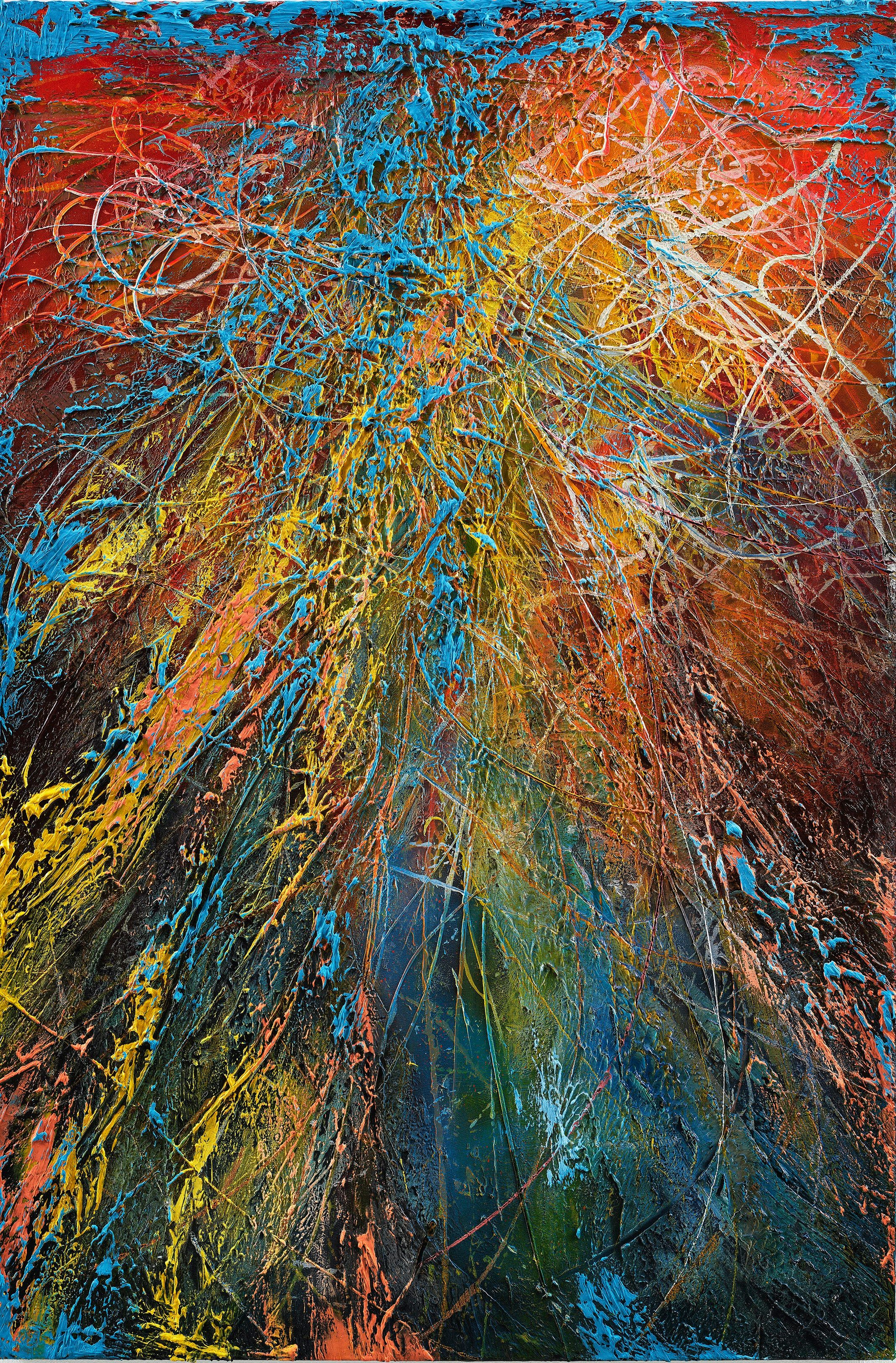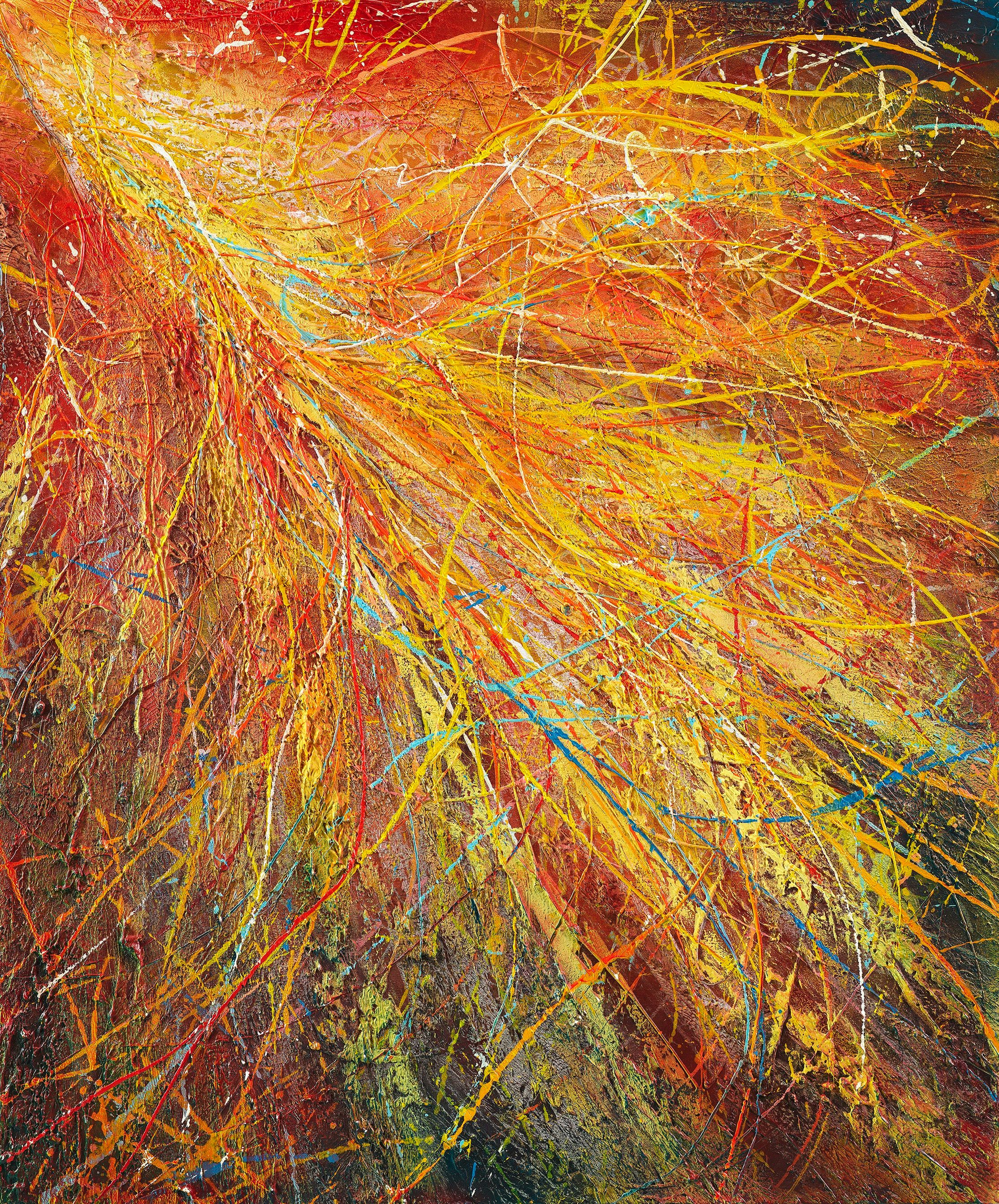
The current exhibition Phosphene by New York-based Cuban artist José Parlá references the sensation we experience when we close our eyes and witness a swirling dance of colourful shapes and dots on the inside of our eyelids, caused by light flooding through the thin layer of skin to the retina. Derived from Greek phōs 'light' and phainein 'to show’, it is perhaps the closest we can ever come to a visual experience of our inner body, and to Parlá the commonality of this experience represents a kind of universal language – being a sensation everyone living experiences, regardless of culture, colour, sex, or creed. The paintings he has created inspired by this phenomena are particularly poignant in that their conceptual genesis lies in the artist's near-death experience with Covid-19 in 2021, which initiated a four-month coma from which no one was sure he would awaken. As such, Phosphene is a profoundly exhilarating series that explores collective experience, memory and, in a sense, the atomic energy that keeps us alive. The series began while the artist was recovering in Miami, Florida, where he began painting outdoors in the sun kissed beauty of nature, as opposed to his urban studio in Brooklyn. He became obsessed with conveying the abstract visual language forming in his mind due to the sensation of the sun penetrating his retina, and in translating that experience directly to the to canvas – the result being a psychedelic interplay of form that blends the strange calligraphy of optic nerve stimulation with painterly abstraction. Here, the artist, speaks to Culture Collective about the experience of returning to the world from the brink of death, and finds out why he has hope that one day the species will transcend beyond a perpetual state of war and violence.
Are these paintings reflective of an awakening in you after the experience of your coma – a sense of light and life flooding back in?
Awakening is actually a really interesting choice of word, because in 2020, I actually did an exhibition titled The Awakening, which obviously predated me being sick. And that was about me and a group of friends who are artists who felt a really deep urgency to come together and do work in the community and educate people about what had been happening since the murder of George Floyd. We formed a group called The Wide Awakes. The Wide Awakes has a deep history that goes back to the abolitionist movement that emerged after the Civil War in the United States, and we sort of wanted to revive a lot of the ideas from back in those days, because a lot of us had experienced police brutality first-hand. So, there was already this notion of societal awakening in my mind, but little did I know that just a year later, I would get sick and wind up in a coma for four months. And, of course, there was then a very literal awakening into the next phase of my life. It's definitely work that is reflective of a rebirth.

What was it like to come out of such an extended coma, how did it affect your perception of reality?
Well, I had a stroke, so it was very serious, and they really didn't think I was going to make it. There were a lot of difficulties. When I woke up, I had absolutely no idea I had been in a coma, and no idea what had even happened to me. I wasn't even what I could call fully awake – it was more like I just had an instinct to wake up. Unusually, they didn't have my hands tied down at the hospital, and there is this natural instinct to start pulling out your tubes … I almost killed myself doing that, so I went back into emergency and they put me back under. When I woke up a second time, the reality that I was registering was the one that I had been dreaming about for four months. To be clear, I wasn't aware I was dreaming when I was in the coma – I only started to process that about two weeks after waking up. I ‘woke up’ believing all sorts of things – I had been kidnapped by the mafia, I was living in hotels all over the world. I had survived a tsunami ... When I was trying to communicate with the doctor and my brother, I believed all of this was absolutely real. They were not allowed to tell me I had been in a coma because that produces too much anxiety – you actually work with a psychologist to slowly kind of ease you back into reality.

Did the idea of a show of paintings based on the phenomena of phosphene come directly from that experience?
The phenomenology of phosphene has always fascinated me. It’s kind of a universal language and I was interested in exploring it as a unifying thread for humanity – even a blind person experiences phosphene. It’s not a language that is legible, of course – it doesn't need to be read. It's more like a feeling, and it's very abstract, and that abstraction has so much power because it allows us to use our imagination. There's no particular form or shape, or landscape, in these works, but there is a language that maybe that reminds you of calligraphy, and shapes that maybe remind you of light. And I kept thinking while making the work that if phosphene enters the skin through your mind's imagination, then does that light continue to travel through your arteries, your blood and your inner landscape, so there are shapes and forms of light in the paintings that look like arteries and veins. It’s all very abstract but, at the same time, it connects you back to a reality that we can all perceive – you can see the textures of walls, textures of mountains, textures of places, and perhaps even strange topographical locations.

Is there a sense of trying to bring people together in the work, in celebrating universal phenomena?
One of the techniques that I use in this work is to weave the colour, and imagine that I'm working with thread. I'm thinking about the fabric of society when I am weaving the forms in the paint, and thinking, metaphorically, about bringing people together. The purpose of that, for me, is that we've all experienced the toughest times since 2020, and ever since the pandemic, things have drastically changed. It really feels like something we've never seen before. They say over 20 million people died in the pandemic, but the number is so abstract, no one really knows. And life just continues to get tougher – politically, socially, economically … Things are getting more and more dangerous. And against that backdrop, I believe the role of the artist has always been to imagine a better world. If you look at these works, they're all about a surge of light producing beams of energy, and that is something that might sound whimsical, but we can't function without energy – the sun, the light; it's the energy that we have in our body.
Do you feel your work has become more purpose driven since you survived the coma?
It was always purpose driven. But, yeah, I've never been so close to dying. And going through the struggle of learning how to eat again, learning how to use my hands again, learning how to walk again, learning to swallow – I mean, that really changes your outlook. Because then you realise so absolutely that there is very limited time. The question for me now is how does my work help others? How can it connect to people's inner questions? And how can it be universal enough that it's literally open for anybody from all walks of life? I've always wanted for people to transcend to another place through my work, and the choice of where they're going becomes their own story. I transcend myself while I'm painting these works, because they are really labour intensive – you're exhausted making them, and go into this state of almost synesthesia. I just hope that viewers find their own way to transcend through these. And on a larger scale, I always hope that one day there will be a major transcendent evolution for humanity.
Phosphene exhibits at Ben Brown Fine Arts, Mayfair, until Nov 16th
Find out more about the artist here.
Images (top to bottom): Portrait of the artist in his studio by Tyler Haft; Amorphous Waves, 2023; Vibrant Heart, 2023; Universal Meditation, 2023. All images courtesy the artist and Ben Brown Fine Arts.